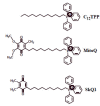Mitochondria-Targeted Drugs
- PMID: 30479224
- PMCID: PMC6875871
- DOI: 10.2174/1874467212666181127151059
Mitochondria-Targeted Drugs
Abstract
Background: Targeting of drugs to the subcellular compartments represents one of the modern trends in molecular pharmacology. The approach for targeting mitochondria was developed nearly 50 years ago, but only in the last decade has it started to become widely used for delivering drugs. A number of pathologies are associated with mitochondrial dysfunction, including cardiovascular, neurological, inflammatory and metabolic conditions.
Objective: This mini-review aims to highlight the role of mitochondria in pathophysiological conditions and diseases, to classify and summarize our knowledge about targeting mitochondria and to review the most important preclinical and clinical data relating to the antioxidant lipophilic cations MitoQ and SkQ1.
Methods: This is a review of available information in the PubMed and Clinical Trials databases (US National Library of Medicine) with no limiting period.
Results and conclusion: Mitochondria play an important role in the pathogenesis of many diseases and possibly in aging. Both MitoQ and SkQ1 have shown many beneficial features in animal models and in a few completed clinical trials. More clinical trials and research efforts are needed to understand the signaling pathways influenced by these compounds. The antioxidant lipophilic cations have great potential for the treatment of a wide range of pathologies.
Keywords: Mitochondria; antioxidants; metabolic syndrome; reactive oxygen species; targeted drug delivery; uncouplers of oxidative phosphorylation..
Copyright© Bentham Science Publishers; For any queries, please email at epub@benthamscience.net.
Figures



References
-
- Davis S.S. Biomedical applications of nanotechnology--implications for drug targeting and gene therapy. Trends Biotechnol. 1997;15(6):217–224. - PubMed
-
- Keservani R.K., Sharma A.K., Kesharwani R.K. CRC Press. 2017. Drug Delivery Approaches and Nanosystems, Volume 2: Drug Targeting Aspects of Nanotechnology.
-
- Burns R.J., Smith R.A., Murphy M.P. Synthesis and characterization of thiobutyltriphenylphosphonium bromide, a novel thiol reagent targeted to the mitochondrial matrix. Arch. Biochem. Biophys. 1995;322(1):60–68. - PubMed
-
- Nicholls D.G., Bernson V.S., Heaton G.M. The identification of the component in the inner membrane of brown adipose tissue mitochondria responsible for regulating energy dissipation. Experientia Suppl. 1978;32:89–93. - PubMed
Publication types
MeSH terms
Substances
LinkOut - more resources
Full Text Sources
Medical

